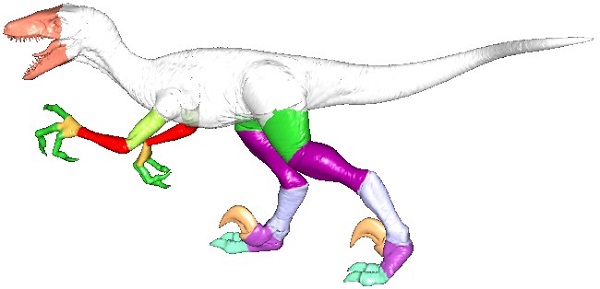Scientists Develop A New Method for Detecting Intrinsic Symmetries on 3D Models
Date:2019-11-04
Symmetry detection on 3D models is important for model understanding and processing. Existing methods are always based on statistics computation. Unfortunately, they may miss the symmetries whose votes are not enough, including the small symmetries and the symmetries embedded in other symmetries. Compared with extrinsic symmetry detection that can employ rigid transformations for fast computation, intrinsic symmetry detection is very expensive as it is related to non-rigid transformations and needs complicated measures such as the geodesic metric. Till now, it is a big challenge for fast and effectively detecting intrinsic symmetries on 3D models.
Based on the observation that intrinsic symmetrical parts have similar topological structures and convex parts can only possess extrinsic symmetries between them, the group proposes a new method for intrinsic symmetry detection. At first, it is extracted the skeleton of the 3D model, and the skeleton is used for guiding convex decomposition of the model, which is further optimized by the concave information of the model. As a result, each junction node and each branch of the skeleton have a corresponding convex decomposed part respectively. Then, in symmetry detection, it is first found the extrinsic symmetries between convex decomposed parts, and then these extrinsic symmetries are used to detect intrinsic symmetries, where similar skeletal structures are found from small to large gradually, and the parts corresponding to similar skeletal structures are regarded symmetrical to each other intrinsically if the corresponding convex parts of the similar skeletal structures are symmetrical to each other respectively. Clearly, the new method gives up statistics computation and complicated measures, and so avoids the shortcomings of the existing methods. It is able to find many more symmetries with the symmetrical parts segmented in high quality, while at a much higher speed than the existing methods.
This work not only proposes a new method for symmetry detection on 3D models, but also provides a solid base for promoting concise 3D model processing as it can find almost all the symmetries on the 3D model. The work is partially supported by the national natural science foundation of China.

Detected small symmetries and embedded symmetries (Image by WANG Wencheng)

Detecting intrinsic symmetries from small to large gradually (Image by WANG Wencheng)
